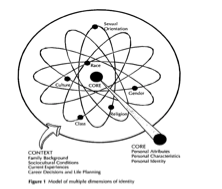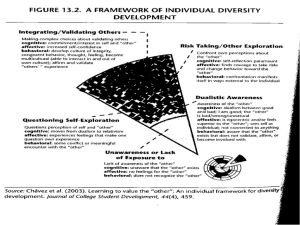This page will look at the following:
- Oppression
- Privilege
- Multiple Identity Dimensions
- Multiracial Identity Development
- Renn’s Ecological Theory of Mixed-Race Identity Development
Oppression
- Those attitudes, behaviors, and pervasive and systemic social arrangements by which members of one group are expoited and subordinated while members of another group are granted privileges” (Bohmer & Briggs, 1991, p. 155).
- Oppressed people are “confined and shaped by forces and barriers which are not accidental or occasional and hence avoidable” (Frye, 2003, p.141).
- “Oppression can take many forms, including exploitation, marginalization, powerlessness, cultural imperialism, and violence” (Young, 2000).
Recognition and Elimination of Oppression
- Examination of the visible and invisible elements and interactions of privilege and oppression
- Utilized to help conceptualize the various options of identification for members of multiple oppressed groups
- Four options: “(1) society assigned-passive acceptance; (2) conscious identification; (3) multiple aspects of self in a segmented fashion; or identity intersection” (Evans et al., 2010, p. 237)
Privilege
- Two types of privileges:
- Unearned entitlements-privileges we should all possess
- Conferred dominance-one person/group power over another
- Research shows an interconnected nature between oppression and privilege and the dominance of one person/group over another in various sectors.
- “The intricate connection between self, others, and environment shapes the awareness and unawareness of privilege” (Evans et. al, 2010, p. 238)
White privilege:
- White privilege is the “system of benefits, advantages, and opportunities experienced by white persons” given purely based on race/skin color (Donnelly, Cook, Van Ausdale & Foley, 2005, p. 6).
Social Class Privilege:
- Typically, social class is associated with income, occupation, and education; thus, power, wealth, social networking attribute to the distinction of the different classes.
- 3 components:
- “a social class of origin, a current felt social class and an attributed social class” (Barrett, 2007, n.p.).
Gender Privilege:
- Attributed to by invisibility
- Research shows that class differentiation may serve as a proponent of gender privilege.
- Women are economically and socially disadvantaged throughout society (Evans, et. al, 2010)
Heterosexual Privilege:
- Most invisible privilege
- Heterosexuality is viewed as normal and other sexual orientations are viewed as wrong or deviant.
Ability Privilege:
- People with disabilities are anything but equal to the normalcy of society, whether by thought or action on the “designated” level prescribed, tends to concentrate on the mental and physical attributes of an individual.
- Society also continues to utilize pity and discount the talents and skills of those with a disability.
Christian Privilege:
- Specific areas have dominant religious traditions and others tend to be discounted or viewed as a lesser amongst the society.
- “Those with Christian privilege have a responsibility to reflect on their privilege and power and create more equitable religious identification patterns” (Evans et al, 2010, p. 243).
- Christians are generally accepted and used in public arena and education, while other religious groups are not afforded the same experience.
Self-Perception of Multiple Identity Dimensions
- The model illustrates “a fluid and dynamic one, representing the ongoing construction of identities and the influence of changing contexts on the experience of identity development” (Jones and McEwen, 2000, p. 408).
- Core sense of self-one’s personal identity (personal attributes and characteristics, and other factors important to the individual)
- Surrounding the core significant identity dimensions
- Race
- Culture
- Gender
- Family
- Education
- Sexual Orientation
- Social Class
- Religion
- Re-Conceptualized Model
- Two-dimensional: Depicting the interaction of context, meaning making, and identity perceptions
- Meaning-making filter serves as the sieve between contextual influences and self-perceptions of multiple identity dimensions.
Multiracial Identity:
-
- “Acceptance of multiracial as an identity is difficult for those who want to consider—an maintain—“the races” as discrete “(Zack, 1995).
- Issues surrounding Multiracial identity:
- Purity View
- Interracial Relationships
- Lack of Acceptance
- Focus on Inclusion and Legitimacy
- Unclear identity – Fitting in
- Approaches to Multiracial Identity Development
- Deficit Approaches
- The idea that biracial and multiracial students are confused and lack belonging in society
- Internal vs. External conflict
- “biracial persons reproted that they saw their multiracial backgrounds as an asset rather than a liability” (Evans et al., 2010, p. 292)
- Stage Theory Structure
- Biracial and drawing on the proponents of each heritage
- Immerson-like stage
- Strong Emotional Content
- Self-awareness and self-appreciation
- Typology Approaches
- Ecological Approaches
Renn’s Ecological Theory of Mixed-Race Identity Development
- Aspects of the Theory
- Identity Patterns
- MonoracialIdentity – Typically with the more salient identity
- MultipleMonoracialIdentity – Consciousness of more than one racial identity, but each identity has a separate place in the individual’s self-concept
- MultiracialIdentity – Integration of all identities as one positive self-concept
- ExtracialIdentity – Individual chooses to identify with a race that is different from his or her mixed heritage
- Situational Identity – Individual chooses one race to identify based on the events/circumstances
Abes, E. S., Jones, S. R., & McEwen, M. K. (2007). Reconceptualizing the Model of Multiple Dimensions of Identity: The Role of Meaning-Making Capacity in the Construction of Multiple Identities. Journal of College Student Development, 48(1), 1-22.
Barrett, W. (2007, April 225). Talking about social class on campus. NASPA’s NetResults. Retrieved May 25, 2009, from http://wbarratt.indstate.edu/documents/talking_about_social_class.htm.
Bohmer, S., & Briggs, J.L. (1991). Teaching privileged students about gender, race and class oppression. Teaching Sociology, 19, 154-163.
Donnelly, D.A., Cook K.J., Van Ausdale, D., & Foley, L. (2005). White privilege, color blindness, and services to battered women. Violence Against Women. 11(1), 6-37.
Evans, N. J., Forney, D. S., Guido, F. M., Patton, L. D., & Renn, K. A. (2010). Student development in college: Theory, research, and practice (2 ed.). San Francisco: Jossey-Bass.
Frye, M. (2003). Oppression. In M.S. Kimmel & A. L. Ferber (Eds.), Privilege: A reader (pp.13-20). Cambridge, MA: Westview Press.
Jones, S. R., & McEwen, M. K. (2000). A conceptual model of multiple dimensions of identity. Journal of College Student Development, 41(4), 405-414.
Young, I.M. (2000). Five faces of oppression. In M. Adams, W.J. Blumenfield, R. Castaeda, H.W. Hackman, M.L. Peters & X. Zuniga (Eds.), Reading for diversity and social justice: An anthology on racism, anti-Semitism, sexism, heterosexism, ableism, and classism (pp.35-49), New York: Routledge.
Zack, N. (1995). Life after race. In N. Zack (Ed.), American mixed race: The culture of microdiversity (pp. 297-307). Lanham, MD: Rowman & Littlefield.
This page was written and created by Stephen Dominy Please use the comment section below to ask questions, provide reflection, discussion and/or feedback. To contact directly about this page, please see Stephen Dominy at stephen.dominy@gmail.com.



Hello! Thank you for organizing and sharing this information. I find it very useful!!